EDitorial Comments
The Unbearable Lightness of Leo
Lately I’ve been revisiting the “Thrilling Group” pulp magazines published by Ned Pines, whose numerous companies included Standard Magazines, Beacon Magazines, Better Publications, and Nedor Publishing Company. Pines, as many of you know, had a fetishistic attachment to the word “Thrilling,” which he used in no less than a dozen magazine titles. (He also had a thing for “Popular” and “Exciting,” which he employed with equal promiscuity.) He published 75 rough-paper magazines between 1931 and 1958, always maintaining healthy market share and outlasting all but one of his major competitors. For most of its existence the Thrilling Group was guided by editorial director Leo Margulies, who enjoyed the respect and admiration of writers and other editors alike.
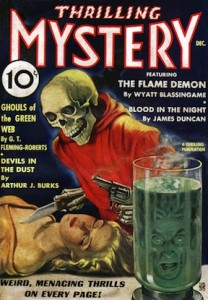 During the Thirties, Pines’s flagship titles included Thrilling Adventures, Thrilling Detective, Thrilling Love, Thrilling Mystery, Thrilling Ranch Stories, Thrilling Sports, Thrilling Western, and Thrilling Wonder Stories. In 1933 he entered the burgeoning single-character field with The Phantom Detective and The Lone Eagle. Pines was not an innovator. He never aspired to lead; he was content to follow. Other publishers took the risks while he sat back to see how they would fare. Street & Smith, having published the first single-genre magazines (Detective Story, Western Story, Love Story, Sport Story), began the hero-pulp revolution with The Shadow. Hugo Gernsback turned science fiction into a viable category with Amazing Stories. In retooling Dime Mystery, Popular Publications created the “weird menace” subgenre. Ned Pines and Leo Margulies tracked the progress of these successful pulps before launching competing titles. In every case they waited for proof that the new trends were sustainable.
During the Thirties, Pines’s flagship titles included Thrilling Adventures, Thrilling Detective, Thrilling Love, Thrilling Mystery, Thrilling Ranch Stories, Thrilling Sports, Thrilling Western, and Thrilling Wonder Stories. In 1933 he entered the burgeoning single-character field with The Phantom Detective and The Lone Eagle. Pines was not an innovator. He never aspired to lead; he was content to follow. Other publishers took the risks while he sat back to see how they would fare. Street & Smith, having published the first single-genre magazines (Detective Story, Western Story, Love Story, Sport Story), began the hero-pulp revolution with The Shadow. Hugo Gernsback turned science fiction into a viable category with Amazing Stories. In retooling Dime Mystery, Popular Publications created the “weird menace” subgenre. Ned Pines and Leo Margulies tracked the progress of these successful pulps before launching competing titles. In every case they waited for proof that the new trends were sustainable.
Not only was Margulies averse to risk, he strenuously opposed the imposition of any personal editorial point of view. The Thrilling pulps had individual editors, at least in a titular sense, but for the most part they were literally edited by committee. Three sub-editors reviewed every story that was tentatively selected for publication. A unanimous vote of approval was necessary to get every yarn published. In disputed cases Leo himself was the final arbiter.
There were exceptions to this process. Margulies reportedly gave Mort Weisinger considerable latitude in the editing of Thrilling Wonder Stories because neither he nor most sub-editors were conversant with the very specific traditions and characteristics of science fiction. The novel-length adventures of the Phantom Detective didn’t see print unless they passed muster with Marcus Goldsmith, an elderly Thrilling Group investor who rather inexplicably maintained a proprietary interest in that particular series. But for the most part, Leo ran things his way.
Of course, you can’t argue with success, and some might think it churlish of me to try. But I’ve never warmed up to the Pines pulps — and not for lack of trying, believe me.
It’s not that Thrilling Group pulps are bad. On the contrary, they were obviously produced with competence if not inspiration. They feature work by solid, professional fictioneers — not the first-tier writers, certainly, but many of the reliable second-tier scribes. And they are nothing if not uniform, a quality that normally is very much to be desired.
But, see, there’s the rub. When uniformity doesn’t rely on excellence, the result is often blandness. And I find the Thrilling pulps bland. They’re assembly-line products that sometimes exhibit ingenuity but never brilliance. They are, in the main, very much like the oeuvre of Norman A. Daniels, one of Margulies’ most prolific contributors. Daniels was nothing if not reliable; he was proficient in multiple genres and could be consistently counted upon to supply readable, entertaining fiction. But I think it’s fair to say that, just as he never wrote a really bad story, he never wrote a really good story. Despite the millions of words he turned out (sometimes in collaboration with his wife), Daniels never penned a truly memorable yarn — which is to say, one that had a life beyond the pulps and latter-day fan-published reprints. You never find him represented in mass-market anthologies of rough-paper stories. His Thrilling Group series characters are cut to familiar patterns and based on those created by better writers for more daring and innovative publishers. In short, he specialized — quite deliberately, I think — in middle-of-the-road pulp fiction.
The entire Thrilling line is middle-of-the-road in concept and execution, with the exceptions of the post-WWII Startling Stories and Thrilling Wonder Stories — which, under the editorial guidance of Sam Mines and Sam Merwin, finally jettisoned the juvenile approach initially taken by Mort Weisinger and Oscar Friend. Both magazines published some truly classic science-fiction stories in the late Forties and Fifties, and I find them to be the liveliest little fillies in the entire Thrilling stable. It’s significant that they were practically the only ones which didn’t have Leo’s bit in their mouths.
 DC Comics editor Jack Schiff, who worked for Pines and Margulies during the Thirties before leaving pulps for funny books, told a Pulpcon audience that Leo saw his magazines as appealing primarily to adolescents. That might account for their blandness. Thrilling Detective and its fellow Pines-published crime mags were the least hard-boiled detective pulps in the business with the exception of Street & Smith’s Detective Story Magazine. At a time when most weird-menace pulps were ratcheting up their levels of sex and sadism, Thrilling Mystery remained positively demure by comparison. The apocalyptic, emotion-drenched, no-holds-barred action of Popular Publications’ The Spider and Operator #5 was nowhere to be found in the pleasant but predictable adventures of the Phantom, the Black Bat, the Masked Detective, or any other Thrilling Group heroes. They were light, airy, fluffy, compared to the sterner stuff dished up by Norvell Page, Frederick C. Davis, and Wayne Rogers.
DC Comics editor Jack Schiff, who worked for Pines and Margulies during the Thirties before leaving pulps for funny books, told a Pulpcon audience that Leo saw his magazines as appealing primarily to adolescents. That might account for their blandness. Thrilling Detective and its fellow Pines-published crime mags were the least hard-boiled detective pulps in the business with the exception of Street & Smith’s Detective Story Magazine. At a time when most weird-menace pulps were ratcheting up their levels of sex and sadism, Thrilling Mystery remained positively demure by comparison. The apocalyptic, emotion-drenched, no-holds-barred action of Popular Publications’ The Spider and Operator #5 was nowhere to be found in the pleasant but predictable adventures of the Phantom, the Black Bat, the Masked Detective, or any other Thrilling Group heroes. They were light, airy, fluffy, compared to the sterner stuff dished up by Norvell Page, Frederick C. Davis, and Wayne Rogers.
I know there still exists among present-day pulp fans a sizable constituency in favor of the Thrilling Group. Let’s hear from some of you. Am I being too hard on Leo and his boys? Opinions, please.
1,039 thoughts on “The Unbearable Lightness of Leo”
Leave a Reply
Recent Posts
- Windy City Film Program: Day Two
- Windy City Pulp Show: Film Program
- Now Available: When Dracula Met Frankenstein
- Collectibles Section Update
- Mark Halegua (1953-2020), R.I.P.
Archives
- March 2023
- July 2021
- May 2021
- March 2020
- February 2020
- December 2019
- November 2019
- October 2019
- September 2019
- August 2019
- May 2019
- April 2019
- March 2019
- February 2019
- December 2018
- November 2018
- October 2018
- August 2018
- June 2018
- February 2018
- December 2017
- October 2017
- September 2017
- August 2017
- May 2017
- April 2017
- February 2017
- September 2016
- August 2016
- July 2016
- June 2016
- November 2015
- October 2015
- September 2015
- August 2015
- July 2015
- June 2015
- May 2015
- April 2015
- March 2015
- February 2015
- January 2015
- August 2014
- July 2014
- June 2014
- May 2014
- April 2014
- January 2014
- December 2013
- September 2013
- August 2013
- July 2013
- June 2013
- May 2013
- April 2013
- March 2013
- February 2013
- January 2013
- December 2012
- October 2012
- September 2012
- August 2012
- July 2012
- June 2012
- May 2012
Categories
- Birthday
- Blood 'n' Thunder
- Blood 'n' Thunder Presents
- Classic Pulp Reprints
- Collectibles For Sale
- Conventions
- Dime Novels
- Film Program
- Forgotten Classics of Pulp Fiction
- Movies
- Murania Press
- Pulp People
- PulpFest
- Pulps
- Reading Room
- Recently Read
- Serials
- Special Events
- Special Sale
- The Johnston McCulley Collection
- Uncategorized
- Upcoming Books
- Western Movies
- Windy City pulp convention
Dealers
Events
Publishers
Resources
- Coming Attractions
- Field Guide to Wild American Pulp Artists
- MagazineArt.Org
- Mystery*File
- ThePulp.Net

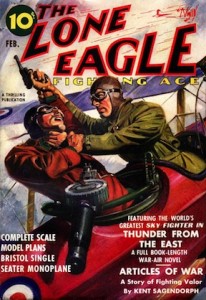

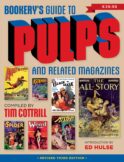
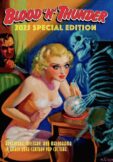
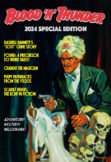
At one time, I collected just about all the Thrilling Group titles. I avoided the love and sport titles but even read some of them also. I would have to say that except for the post WWII SF titles of STARTLING and THRILLING WONDER, I ended up being very disappointed. I sold all my Thrilling Group sets except for the SF.
For instance, I once had a complete set of THRILLING ADVENTURE, in very nice shape and despite having high hopes for the fiction, I found it to be definitely third rate compared to such excellent magazines like ADVENTURE, ARGOSY, ALL STORY, BLUE BOOK, SHORT STORIES, POPULAR MAGAZINE. When a Hubbard collector offered to buy it from me, I quickly accepted.
The Thrilling Group hero pulps I found to be very bland and uninteresting. Not long ago, I had an opportunity to buy a complete set of PHANTOM DETECTIVE in beautiful shape and turned it down because I considered the magazine unreadable.
THRILLING MYSTERY I also sold because it just could not compare to HORROR, TERROR, and DIME MYSTERY. Same with POPULAR AND THRILLING DETECTIVE. They looked poor next to BLACK MASK, DIME DETECTIVE, and the other Popular Publication detective pulps.
The western titles also disappointed me. It looks like they got what they paid for. They paid some of the lowest pulp word rates and as a result, they got lower quality work and rejects from the other magazines.
I liked some of the covers however…
I like all the Western pulps published by the Thrilling Group, especially TEXAS RANGERS, THE RIO KID, and THRILLING WESTERN. I think you’re right, Ed, that there were few really outstanding stories, but I value that consistency. And those Jim Hatfield and Rio Kid paperback reprints hit me at just the right time to make me a big fan.
I generally enjoy the Phantom Detective and Black Bat yarns, but they’re all over the place in terms of quality. Never read much from Thrilling’s regular detective titles, I prefer BLACK MASK and DIME DETECTIVE.
Dunno, Ed, I have not read enough of the Thrilling line of pulps to know better. I do know that Popular Pulps must have been better distributed and were much better written ( at least of the ones I have read). Gotta read the Spider I got last week and then read a Phantom Detective to compare. Have to agree with Walker, they had some great covers though…Should post that Thrilling Western ( I also got last week) of the guy crashing out at the reader with guns blazing…Jonathan
Thrilling Mystery did have some stunning covers. Too bad the fiction inside the covers was not nearly as thrilling or exciting.
Popular certainly packaged their pulps more eye-catching than the Ned Pines’ line, but I do believe most writers crossed over at one time or another. Daniels was published in most publishing houses. I also believe that Leo accomplished exactly what they intended with the magazines at the time. They sold them! I am probably one of the few “thrilling” fans out there, probably, and actually enjoyed The Phantom Detective and Black Bat – along with all the other heroes from the group. Page’s Spider was too violent, and the destruction of New York City in every story got to be a little old after a while. My favorite “hero” pulp, however is, and will forever be, The Shadow from Street & Smith. Loved your article, Ed.
Walker, have to agree with you on the Thrilling magazines.I found a lot of good stories there but overall the magazines were average.One exception that I found however,was The Lone Eagle.Don’t know who the author was but he put together a good series.To me it was the class of the Air War character pulps.Of course compared to G-8 almost anything looked good.Nippy and Bull were kept around for comic relief.Rather like Monk and Ham in Doc Savage (of course I know how much you enjoyed them).The Lone Eagle fought WWI around the world,even in Mexico where he foiled a projected attack on the US by Germany.And the magazine had pretty decent characterization at least compared to the rest of the Thrilling group.Worth collecting.
Hi,
I am Leo’s nephew; he was my mother’s brother. (I am 83.) Not only was Leo an outstanding editor and publisher, as you and many others have written, he was also an outstanding uncle. He was so much fun, more than my father was. He once bought me a copy of every comic book (perhaps, 60 or so) in a soda fountain we visited. He often played hide-and-seek with my sister and me. He was a ball of fun. I was crazy about him. He and Cylvia would come for dinner most Sundays. I once did some proofreading for him (in 1947 or so), at 2 cents a word! A small fortune to me!
I am now writing a memoir of my life, and the chapter on Leo may be the greatest of them. Thank you for keeping his memory alive, with “The Unbearable Lightness of Leo,” published on his birthday, a year ago. I am so proud of him, knowing that he is still thought of so highly.
Should you wish to, you may publish these comments.
Hi, I wrote earlier, mentioning my memoir. I am now seriously considering writing his biography, as a book. Please send me information about him. Although I already have a great deal, I can always use more, especially details about his many ventures.
many, many thanks.
Philip
Well, I am proceeding with the book I mentioned earlier.
The comments about the Thrilling Group and (especially) Leo Margulies) are of much interest. They appear to be at such odds with the general feeling about the man. How do others feel? Were the pulps better when he kept his hands off them somewhat?
Philip